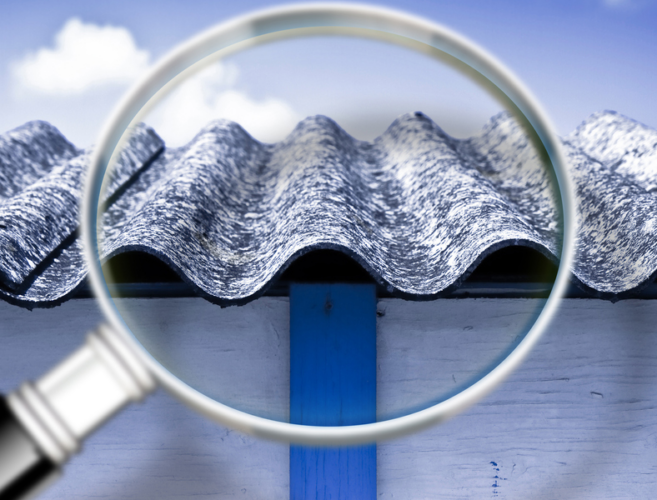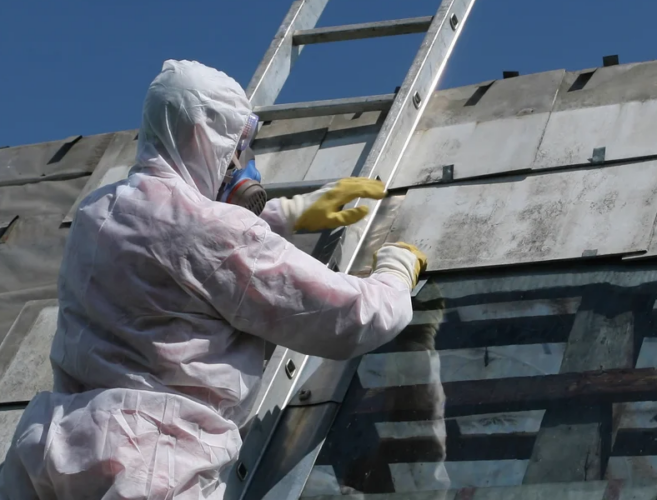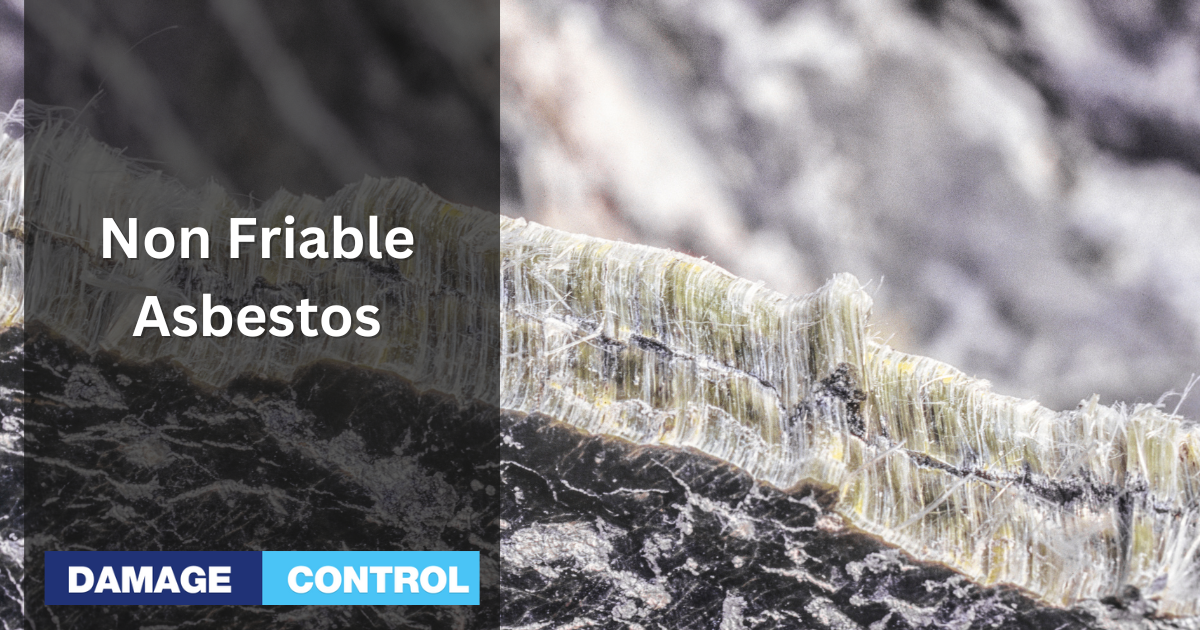Non-friable asbestos is a type of asbestos-containing material considered to be of lower risk than friable asbestos. This is because non-friable asbestos is mixed with cement or other hard bonding materials, making it less likely to become airborne and, therefore, less likely to be inhaled.
However, it is important to note that non-friable asbestos can still pose a health risk if it is damaged or old.
Non-friable asbestos is commonly found in building materials such as floor tiles, a variety of roofing materials, and you should be able to identify certain insulations prone to being asbestos laden. It is important for property owners and managers to properly identify and manage any non-friable asbestos-containing materials in their buildings to ensure the safety of occupants and workers. This may involve regular inspections, maintenance, and removal or encapsulation of any damaged or deteriorating materials.
What is Non Friable Asbestos?

Non-friable asbestos is a type of asbestos-containing material that is not easily crumbled or pulverized by hand pressure. It is generally part of an indurated material that will not yield until under substantial effort. This means that human contact and weathering are unlikely to release non-friable asbestos.
On the other hand, non-friable asbestos-containing material is defined as material containing more than 1% asbestos that cannot be crumbled or pulverized by the human hand. Non-friable ACM is divided into two categories. Category I includes asbestos packaging, gaskets, resilient floor covering, and asphalt roofing products.
Unlike friable asbestos, non-friable asbestos is generally considered less hazardous because it is less likely to release asbestos fibers into the air. However, cautiously handling non-friable asbestos-containing materials is still important to avoid potential exposure to asbestos fibers.
Non-friable asbestos-containing materials can become friable if they are damaged or deteriorate over time. For example, if non-friable asbestos-containing materials are disturbed during renovation or demolition activities, they can become friable and release asbestos fibers into the air.
Suppose you suspect you have non-friable asbestos-containing materials in your home or workplace. In that case, it is important to have them properly identified and managed by a qualified asbestos professional. They can help you determine the best course of action to minimize the risk of exposure to asbestos fibers.
Health Risks Associated with Non Friable Asbestos
Non friable asbestos is a term used to describe asbestos-containing materials that are not easily crumbled or pulverized. These materials are typically found in building materials such as floor tiles, roofing shingles, and cement pipes.
Although non friable asbestos is less likely to release fibers into the air than friable asbestos, it can still pose health risks if it becomes damaged or deteriorated. When asbestos fibers are inhaled, they can become lodged in the lungs and cause a variety of health problems.
Breathing in asbestos fibers can lead to the development of asbestosis, a chronic lung disease that can cause shortness of breath, coughing, and permanent lung damage. Asbestosis can take years to develop and can be difficult to diagnose, as its symptoms are similar to those of other respiratory conditions.
In addition to asbestosis, exposure to asbestos can also increase the risk of developing lung cancer and mesothelioma, a rare and aggressive form of cancer that affects the lining of the lungs, abdomen, or heart. These diseases can take decades to develop and are often fatal.
It is important to note that the health risks associated with non friable asbestos are highest for individuals who are exposed to the material on a regular basis, such as construction workers or individuals who work in older buildings. However, even short-term exposure can be harmful, particularly for individuals who smoke or have pre-existing respiratory conditions.
To minimize the risks associated with non friable asbestos, it is important to avoid disturbing or damaging asbestos-containing materials whenever possible. If these materials must be removed or repaired, it should be done by a licensed professional who is trained in safe asbestos handling practices.
Where is Non Friable Asbestos Found?
Non-friable asbestos products are commonly found in buildings constructed before the 1980s. These products were widely used in construction materials, including roofing, flooring, insulation, and cement products. The following are some examples of where non-friable asbestos can be found:
- Asbestos cement sheeting (also known as “fibro”)
- Vinyl asbestos floor tiles
- Asbestos cement pipes and flues
- Asbestos-containing insulation in HVAC systems
- Asbestos-containing roofing materials
- Asbestos-containing adhesives and sealants
- Asbestos-containing electrical components
It is important to note that non-friable asbestos products are not a significant health risk unless they are damaged or disturbed. If these materials are in good condition and left undisturbed, they pose little to no risk. We also have a good article on identifying and dealing with asbestos roofing.
Non-friable asbestos products can become friable if they are damaged or disturbed, such as during renovations or demolition. This can release asbestos fibers into the air, which can be inhaled and cause serious health problems. It is important to hire a licensed asbestos professional to safely remove any damaged or friable asbestos-containing materials.
It is also important to note that non-friable asbestos products can still pose a risk if they are not properly maintained. Over time, these materials can deteriorate and become damaged, which can release asbestos fibers into the air. It is important to regularly inspect non-friable asbestos products and address any damage or deterioration immediately.
How to Identify Non Friable Asbestos
Non friable asbestos is a type of asbestos that is not easily crumbled or reduced to powder by hand pressure. It is a more durable and resistant form of asbestos that is less likely to release dangerous fibers into the air. Here are some tips on how to identify non friable asbestos:
- Look for non friable asbestos in building materials such as roofing shingles, floor tiles, and cement pipes. These materials are often made with asbestos fibers that are bound together with a binding agent, which makes them less likely to crumble or break apart.
- Check the age of the building. If the building was built before the 1980s, it may contain non friable asbestos. This is because asbestos was a common building material before its health risks were discovered.
- Look for warning labels or signs that indicate the presence of asbestos. These labels may be found on pipes, ducts, or other building materials that contain asbestos.
- Hire a licensed asbestos assessor to conduct a thorough inspection of the building. They can take samples of suspected asbestos-containing materials and test them in a laboratory to determine if they are non friable.
- Use caution when handling any suspected asbestos-containing materials. Do not disturb or damage them in any way, as this can release dangerous fibers into the air. If you must handle them, wear protective clothing and a respirator mask.
Regulations and Guidelines for Non Friable Asbestos Removal
Non friable asbestos materials are those that contain asbestos fibers that are firmly bound in a matrix. These materials are less likely to release asbestos fibers into the air unless they are disturbed or damaged. The removal of non friable asbestos materials is regulated by federal and state laws to ensure the safety of workers and the public.
The Occupational Safety and Health Administration (OSHA) regulates the removal of non friable asbestos through its Asbestos Standard for the Construction Industry (29 CFR 1926.1101). This standard requires employers to protect workers from exposure to asbestos fibers during the removal of non friable asbestos materials. Employers must provide workers with appropriate respiratory protection, protective clothing, and training on safe work practices.
In addition to OSHA regulations, the Environmental Protection Agency (EPA) also regulates the removal of non friable asbestos. The National Emission Standard for Asbestos (40 CFR Part 61 Subpart M) requires owners and operators of asbestos mills to either discharge no visible emissions to the outside air or use methods to clean emissions containing particulate asbestos material before they escape to the outside air.
The EPA also requires that any renovation or demolition of structures containing non friable asbestos materials must be thoroughly inspected for the presence of asbestos. If asbestos is found, the materials must be removed by a licensed asbestos abatement contractor in accordance with state and federal regulations.
State regulations may also impose additional requirements for the removal of non friable asbestos materials. It is important for contractors and building owners to check with their state environmental agency to ensure compliance with all applicable regulations.
How to Safely Remove Non Friable Asbestos

Non friable asbestos is a type of asbestos that is not easily crumbled or pulverized. However, it can still be dangerous if not handled properly. Here are some steps to safely remove non friable asbestos:
- Wear protective gear: Before starting the removal process, it is important to wear protective gear such as a respirator, gloves, and disposable coveralls to prevent exposure to asbestos fibers.
- Wet the area: Wetting the area with a fine mist of water will help to control dust and prevent fibers from becoming airborne.
- Use hand tools: Non friable asbestos can be removed using hand tools such as a putty knife or scraper. Avoid using power tools as they can generate dust and increase the risk of exposure.
- Double bag and label: Once the non friable asbestos has been removed, it should be double bagged in 6-millimeter plastic bags and sealed in a leak-tight container with a lid and proper labeling. The materials must be disposed of in landfills designated to handle asbestos waste.
- Clean up properly: After removal, the area should be thoroughly cleaned using wet wipes or a HEPA vacuum to control dust. A HEPA vacuum is used to clean up the area when the abatement is finished.
It is important to note that homeowners may remove non friable asbestos if allowed by state protocol but disposal regulations must be followed. If you’re considering removing asbestos yourself, it's important to consult your state's regulations.
Disposal of Non Friable Asbestos
Non-friable asbestos is a type of asbestos-containing material that is not easily crumbled or pulverized into powder by hand pressure. Examples of non-friable asbestos-containing materials include floor tiles, cement pipes, and panels. Although non-friable asbestos-containing wastes are considered non-hazardous, they still need to be disposed of properly to prevent potential health risks.
When disposing of non-friable asbestos, it is important to follow the regulations set by your local authorities. Here are some guidelines you should follow:
- Contact your local landfill operator to determine if they accept non-friable asbestos-containing materials. If they do, ask how they want the material packaged.
- Always wet the material before removal to prevent the release of asbestos fibers into the air.
- Double-bag the material in heavy-duty plastic bags, seal them tightly, and label them as containing asbestos.
- Transport the material to the landfill in a leak-proof vehicle.
- Inform the landfill operator that the waste contains asbestos and provide them with the relevant documentation.
It is important to note that non-friable asbestos-containing materials removed by non-friable methods do not have to be disposed of in licensed asbestos landfills. However, it is still recommended that you dispose of the material in a responsible manner to prevent any potential health risks.

